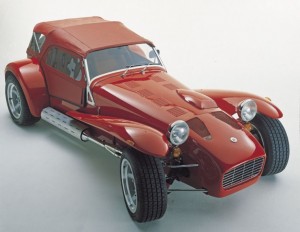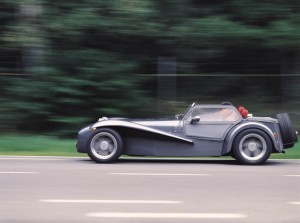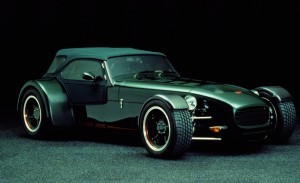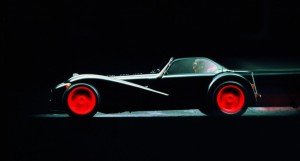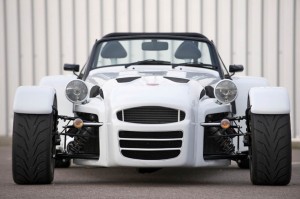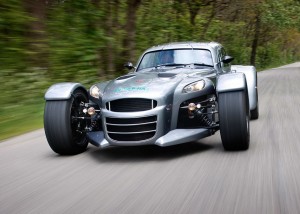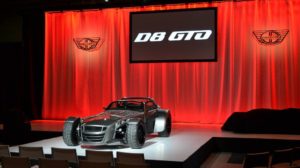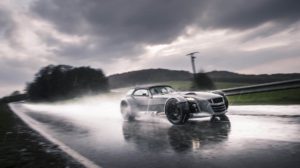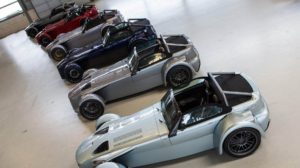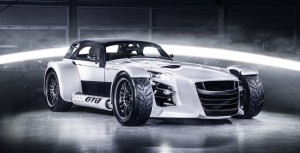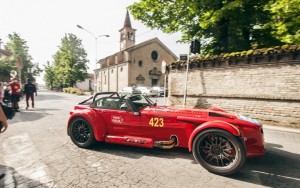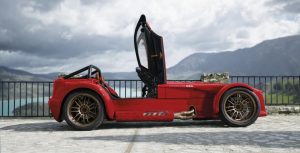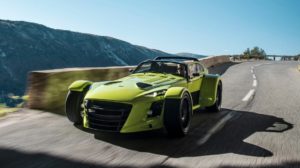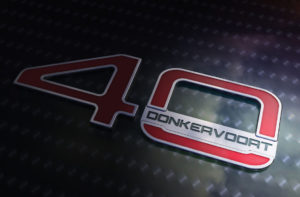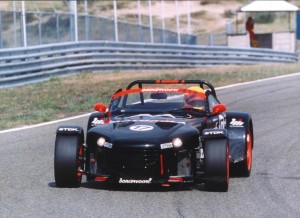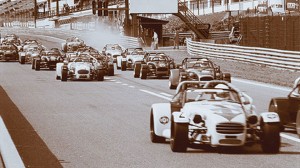The S7 was the first Donkervoort to ever leave the factory. The car had a 1.6 litre Ford engine and a four-speed gearbox. The front wheel suspension consisted of Triumph parts, the rear axle stemmed from Ford. The S7 was simply sensational for the time, with a top speed that was above a respectable 170 km/h.
The successor to the S7 was the S8. The S8 was a better and especially more modern car in many aspects. The front track was larger and the engine in the S7 made way for a 2.0 litre Ford OHC engine with 110 bhp. The S8 was equipped with a 5 speed gear box. A lot of attention was paid to passive safety in both models: they had a double braking system with the possibility to adjust the brake balance at the front and rear, and twin aluminium fuel tanks mounted directly in front of the rear axel.
Donkervoort S8A
In 1985, the S8A came on the market. The car was sold as a completion to the S8 range which was scheduled to continue until 1989. The car was modernised in many aspects. The chassis was wider and at the same time lighter and fitted with aluminium panels that were glued and attached with blind rivets. A revolutionary method that had never been used before in the automobile industry. Other special features included independent rear wheel suspension and electronic fuel injection. The S8A was also revamped in terms of style. The nose and side fenders were given a more elegant, streamlined shape. The S8A was in production until 1993. The ‘A’ in the type name S8A stands for Amber, the daughter of Donkervoort founder Joop Donkervoort. When Amber was born, her first drive from the hospital toward home was in a Donkervoort!
Donkervoort S8AT
The S8AT was introduced to meet the increasing demand for more power. Its engine was exceptional: the Ford engine from the S8A was fitted with a turbo, which increased its output from 117 to 170 bhp. A welcome development since the catalytic converter became obligatory, which lowered the output of the standard Ford engine instead of increasing it. At the same time, the development a ‘new’ engine like that was a considerable undertaking.
But it was not just technical changes to the engine that were new. The chassis was widened once again and made remarkably stiffer. The front and rear suspension was replaced and from 1991 on, disk brakes were standard on the rear axle.
Donkervoort D10
The D10 was probably one of Donkervoort’s most extravagant creations. In 1988, the factory had been in existence for ten years and to mark the occasion in style, the D10 was introduced at the Paris Auto Show. It had to be a car that showed in a single glance everything Donkervoort stood for. And it succeeded. The D10 was extreme in every aspect. The lack of windscreen gave the driver the sensation that a Formula 1 driver was supposed to feel. A matching helmet provided the only protection against flying objects and insects. Symbolically for the name, only 10 D10 cars were built. To underpin the sporty performance of the D10, in 1989, on a closed-off section of the motorway, it broke the world acceleration record for production cars: from 0 to 100 km/h in just 4.85 seconds.
Donkervoort D8 Zetec
In 1993 the successor to the S8AT came on the market. Ford introduced the Zetec engine and with it, offered a splendid alternative to the then already old S8AT engine. Despite the fact that the output was not especially high, owing to its significantly lower weight, the Zetec was well known as a fast, but mainly smooth driving car.
In 1994, as an addition to the Zetec Classic, the Zetec Sport was introduced. This was the first time that repeated use was made of carbon fibre, which was used to manufacture the extremely light and yet sturdy body parts. In their own factory, that is. The spare wheel that was still prominently present on previous models was left out, the battery was replaced by a smaller model and the cast iron clutch housing made way for an aluminium model. The new nose with modern grill, the equally new scuttle and the curved windscreen all made the car look a lot more modern, just as the adjustable WP shock absorbers and cycle wings that today are the distinguishing mark of Donkervoort.
Donkervoort D8 Cosworth
In 1985, Ford and Cosworth introduced a new turbo engine that turned out to be a wonderful power source for Donkervoort, and in 1994 the D8 Cosworth came into existence. With a top speed of 235 km/h and an acceleration of 0 to 100 km/h in just 4.1 to 4.8 seconds, the Cosworth was extremely fast. In those days there were hardly any faster cars on the market. The output varied from 220 bhp to 280 bhp and more.
The D8 Cosworth was a notorious and feared car especially on the track. Driving skills obligatory. Just like the Zetec, the Cosworth was available in two versions. The Cosworth Classic still had the traditional long guards while the Cosworth Sport was fitted with cycle wings.
Donkervoort D8 Audi (AGU)
In the late nineties an alternative to the Ford engines was found. Cosworth stopped production of the engine, so a successor had to be sought. Audi made beautiful engines and proved to be very interested in supplying them to Donkervoort. The 1.8T 20V AGU engine made its first appearance in the D8 series. For the first time in the history of the brand a transition was made to a new engine supplier. The Audi engine had a number of major advantages over the engines used in the past. Among other things, the Audi engine was lighter and more compact, and it effortlessly met the strictest emission standards.
A further significant improvement was that Donkervoort also began producing the chassis in-house in that period. The result, a significantly stronger and stiffer chassis, together with all the other changes, made the D8 Audi a real phenomenon.
Donkervoort D8 Audi (E-gas) Wide Track
From 2003, Donkervoort began using the Audi 1.8T 20V E-Gas turbo engine. This engine had been fully proven in terms of reliability, while it also met the new emission standards, primarily due to the electronic throttle control (E-Gas).
The compact, lightweight construction of the engine was also important. All these features made this engine superbly suitable for use in a Donkervoort. In the D8 the engine was available with four power ratings: 150 hp, 180 hp, 210 hp and later also 270 hp. Combined with a total weight of just 630 kg, this made the D8 extremely fast. Depending on the type, the 0 to 100 km/h acceleration took from just 3.8 to around 5.2 seconds.
Donkervoort D8 270 RS
The D8 270 RS was a tribute to the prestigious record Donkervoort broke in 2004 and 2005 on the notorious Nordschleife of the famous Nürburgring. This lap record for street-legal cars was long held by a renowned German sports car manufacturer. Donkervoort crushed the old record, bettering it by a whopping 15 seconds, which put the brand in the international spotlight in one fell swoop.
The Donkervoort D8 270 RS, named after the D8 RS with which the record was broken, was introduced in a limited series of 25 cars. Several improvements over the 210 hp version were the increased power of 270 hp and a new nose design that could accommodate more and larger coolers. The weight remained virtually unchanged. The D8 270 RS could pride itself on being one of the fastest cars Donkervoort ever built. Acceleration from 0 to 100 km/h took just 3.6 seconds, deceleration from 100 to 0 just 2.4. The D8 270 RS proved to be one of the best creations in Donkervoort’s history, and one of the most desirable: the 25 units were reserved and sold in a few short months.
Donkervoort D8 270
Subsequently, in 2008, the D8 270 became available. It was the top version of the D8 series and a logical successor to the successful D8 270 RS. The D8 270 offered a sensational – and above all fast – driving experience, with a 0-100 km/h acceleration of 3.6 seconds. The D8 270 was fitted with a new nose and grill design that was a direct nod to the D8 GT introduced a year earlier.
Donkervoort D8 GT
In 2007 the press and public were introduced to the first hard-top Donkervoort during the Geneva Motor Show – a full-blooded GT with two personalities packaged in an exciting design. On the one hand, there is the purebred high-tech racer, designed from a passion for motor racing and built on the basis of 30 years’ experience on the European tracks. Secondly, the stylish ‘Grand Tourer’ that conjures up the romantic feeling of the fast GTs of yesteryear. The Donkervoort D8 GT combines the best of both worlds in an elegant body, built and finished to perfection with outstanding workmanship by dedicated craftsmen.
Compared to the cabrio Donkervoort D8, the technical design of the D8 GT was almost entirely new. In particular, significant changes were made below the surface. The suspension was tweaked to provide even better handling characteristics, the track was widened by a considerable 8 centimetres, larger brakes, specially developed by Italian firm Tarox for maximum deceleration, were fitted, as were 17″ forged aluminium wheels, custom-made for the D8 GT by Japanese specialist Rays Engineering. All these efforts were not in vain: at 650 kg, the Donkervoort D8 GT was the world’s lightest GT. The use of carbon fibre, in particular, contributed greatly: the entire roof, the whole back end, and the doors and fenders were made of this high-tech material. It provided the Donkervoort D8 GT with its unrivalled torsional stiffness and increased passive safety.
In subsequent years the D8 GT participated in the FIA GT4 European Cup, where the car finished second in the championship. Donkervoort Racing also took the D8 GT to the 24H of Dubai in 2011 and brought home the victory cup.
End 2011 – Introduction of D8 GTO
In December 2011, Donkervoort unveiled the first prototype of the new D8 GTO during a sneak preview. This newly developed Donkervoort – which shared just 5% of its parts with the D8 270 and around 30% with the more recent D8 GT – was seen as the next generation of Donkervoort. The D8 GTO is fitted with the longitudinally mounted 5-cylinder 340 hp 2.5 litre TFSI engine from Audi. What’s more, the body is made entirely of carbon fibre composite components. The D8 GTO is also about 35 inches longer and 15 inches wider than its predecessors.
2012 – European small series type approval D8 GTO
In 2012, the latest Donkervoort model successfully attained the new European Community Small Series Type Approval (ECSSTA). This is not only accepted in all European countries, but also in Switzerland, Russia and the Gulf States. Not only does the approval demonstrate the even higher quality and technical excellence of the car, it also gives Donkervoort access to new markets such as those in Russia, Eastern Europe and the Gulf States.
2013 – First delivery D8 GTO
During the summer of 2013 the first six D8 GTOs were delivered. These Premium GTOs are ‘numbered copies’ with a very exclusive sports package, which will not return in the later production versions. After delivery of all the Premium GTOs, production of the ‘regular’ D8 GTOs is set to begin in 2014.
January 2015 – D8 GTO Bilster Berg Edition
April 2015 – D8 GTO Bare Naked Carbon Edition
June 2015 – 1000 Miglia Edition
April 2016 – Introduction D8 GTO-S
December 2016 – The return of the legendary RS
In December of 2016, Donkervoort shows the very first images of the next generation D8 GTO. Even purer, even more extreme and even faster, and the return of the legendary ‘RS’. Thanks to the significant aerodynamic improvements and a fully updated engine management system, the Donkervoort D8 GTO RS is the fastest and most extreme GTO ever built. In addition, the GTO-RS includes a première: it marks the first time Donkervoort has utilised the patented X-Core production method for carbon fibre components it developed in-house.
12-05-2018 – Introduction of the D8 GTO…
Prototypes
Donkervoort D20
In 1998, the first steps were taken for a joint venture with Audi. Back then, the head of Audi, Peafgen, – currently the big boss at Bentley – personally backed working in partnership with Donkervoort and is the driving force behind the production of the D 20. Audi didn’t just provide engine know-how, but also supported all other developments on this jubilee model.
Up to then, all Donkervoorts had the engine and gearbox in the front and the power on the rear wheels. The D20 however was built according to the transaxle principle, in which the engine remained at the front, but the gear box was mostly moved to the real axle; ideal weight distribution and which then resulted in better road holding. The traction also benefited from the wheel suspension with its push rods and a chassis whose stiffness increased by a factor of no less than 6.7. The six cylinder engine used ultimately provided the D20 with 280 bhp.
Unfortunately it turned out that the D20 in combination with this Audi engine was not able to meet the every stricter emission requirements and was excluded from type approval. That is why it was decided to further develop the existing D8 model in combination with the sportier 1.8T engines were used at that time for the Audi TT.
Donkervoort J25
Under the code name J25, Donkervoort developed – right before its 25 year jubilee – a completely new car. This model went a step further in its styling than its predecessors the S8 and D8. The, for that period, very modern lines and a number of details, such the little doors and nose used, were derived from the D20. The J25 was also the first Donkervoort to be produced with 270 bhp.
Donkervoort CUP
Donkervoort is one of the few car makes that are suitable for driving to racetrack, taking part in a race there and afterwards, driving back home. In addition to fairness on the track, the mark of a Gentleman’s Racing class. That explains the years (1993-2001) of continuous success of the Donkervoort Cup. A racing class with and for enthusiastic and competition-minded Donkervoort drivers with races in the Netherlands, Germany, Belgium and a number of other countries, in which everything was provided, such as technical assistance, tyre service hospitality and catering.

